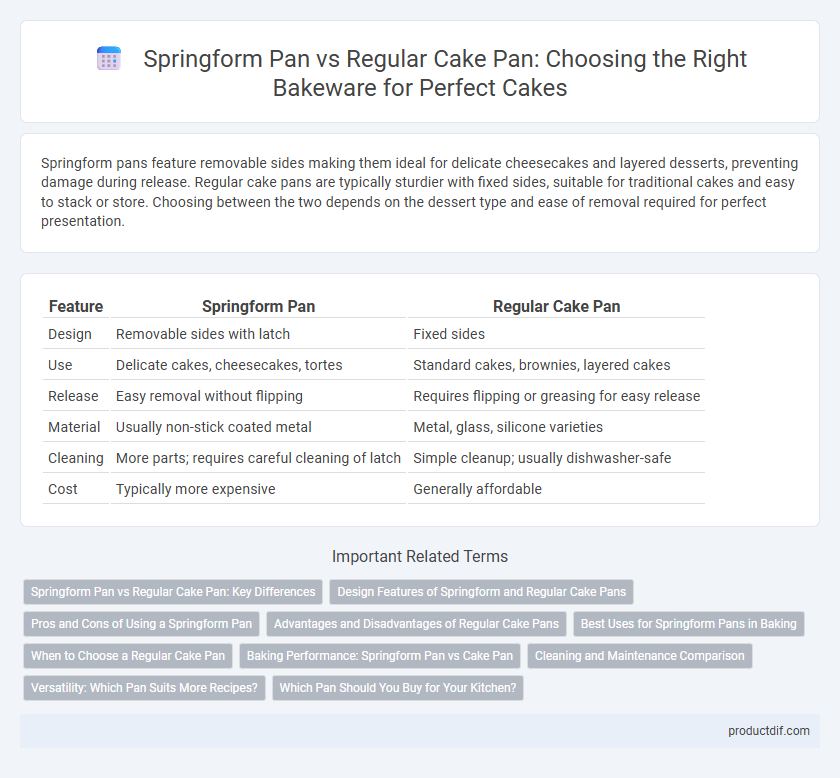Springform pans feature removable sides making them ideal for delicate cheesecakes and layered desserts, preventing damage during release. Regular cake pans are typically sturdier with fixed sides, suitable for traditional cakes and easy to stack or store. Choosing between the two depends on the dessert type and ease of removal required for perfect presentation.
Table of Comparison
| Feature | Springform Pan | Regular Cake Pan |
|---|---|---|
| Design | Removable sides with latch | Fixed sides |
| Use | Delicate cakes, cheesecakes, tortes | Standard cakes, brownies, layered cakes |
| Release | Easy removal without flipping | Requires flipping or greasing for easy release |
| Material | Usually non-stick coated metal | Metal, glass, silicone varieties |
| Cleaning | More parts; requires careful cleaning of latch | Simple cleanup; usually dishwasher-safe |
| Cost | Typically more expensive | Generally affordable |
Springform Pan vs Regular Cake Pan: Key Differences
Springform pans feature removable sides and a latch mechanism, offering easy release for delicate cakes like cheesecakes, whereas regular cake pans have fixed sides requiring inversion or careful loosening for cake removal. The non-stick surface and leak-proof seal of springform pans prevent batter leakage and ensure clean edges, unlike most regular cake pans that might spill thin batters. Springform pans excel in recipes needing gentle handling and layered presentations, while regular cake pans are versatile for everyday baking of sponges, brownies, and sheet cakes.
Design Features of Springform and Regular Cake Pans
Springform pans feature a removable ring that unclamps from the base, allowing for easy release of delicate cakes such as cheesecakes without inverting. Regular cake pans are constructed as solid, fixed containers, typically made of metal or silicone, designed for straightforward mixing and baking but requiring cake inversion for removal. The unique latch mechanism in springform pans provides versatility for layered and fragile desserts, whereas regular pans offer durability and uniform heat distribution for standard cake recipes.
Pros and Cons of Using a Springform Pan
Springform pans feature removable sides that make it easier to release delicate cakes, cheesecakes, and layered desserts without damaging their shape, offering superior presentation compared to regular cake pans. Their design allows for easy slicing and serving, but they may leak batter during baking if not properly secured, requiring a leak-proof base or liner. Regular cake pans provide sturdier sides that prevent leakage and promote even heat distribution, but they can make cake removal more difficult, especially for fragile baked goods.
Advantages and Disadvantages of Regular Cake Pans
Regular cake pans offer durability and versatility, suitable for a wide range of baked goods such as cakes, brownies, and casseroles. Their solid, enclosed sides provide even heat distribution, resulting in consistent baking but often require greasing or parchment to prevent sticking. However, unlike springform pans, regular cake pans can make delicate cakes harder to remove without damaging their shape, limiting their use for cheesecakes or layered desserts.
Best Uses for Springform Pans in Baking
Springform pans are ideal for delicate desserts like cheesecakes, tarts, and layered cakes that require careful removal without damaging their structure. Their removable sides allow for easy release of sticky or fragile baked goods that traditional cake pans might struggle with. These pans excel in recipes where maintaining the presentation and shape of the dessert is crucial.
When to Choose a Regular Cake Pan
A regular cake pan is ideal for recipes requiring even heat distribution and a sturdy structure, such as dense cakes, brownies, and layered desserts. Its solid sides prevent batter leaks and provide firm support, making it perfect when structural integrity is crucial. Choose a regular cake pan for recipes where ease of slicing and serving without the risk of batter spillage is a priority.
Baking Performance: Springform Pan vs Cake Pan
Springform pans provide superior baking performance for delicate cakes, such as cheesecakes, due to their removable sides that prevent cake damage during release. Regular cake pans, made from materials like aluminum or non-stick coated steel, offer even heat distribution that supports consistent baking and browning. The choice between springform and regular cake pans influences texture and presentation, with springform pans excelling in retaining moisture and supporting delicate structures.
Cleaning and Maintenance Comparison
Springform pans feature removable sides and a latch mechanism, making them easier to clean thoroughly compared to regular cake pans with fixed sides. The detachable components allow for better access to all surfaces, reducing residue buildup and simplifying maintenance. Regular cake pans typically require more scrubbing, especially around corners and edges, increasing cleaning time and effort.
Versatility: Which Pan Suits More Recipes?
Springform pans offer greater versatility for delicate cakes like cheesecakes and tortes, as their removable sides prevent damage during removal. Regular cake pans are ideal for traditional layer cakes and can be used in a variety of baking tasks, including roasting vegetables or baking casseroles. Overall, springform pans excel in recipes requiring gentle handling, while regular cake pans suit a broader range of baking applications.
Which Pan Should You Buy for Your Kitchen?
A springform pan offers easy release for delicate cakes like cheesecakes and tortes, making it ideal for bakers who prioritize presentation and gentle removal. Regular cake pans are versatile, durable, and perfect for everyday baking of standard cakes, cupcakes, and brownies. Choose a springform pan if you frequently bake layered or fragile cakes, while a regular cake pan suits general baking needs and budget-conscious kitchens.
Springform Pan vs Regular Cake Pan Infographic

 productdif.com
productdif.com